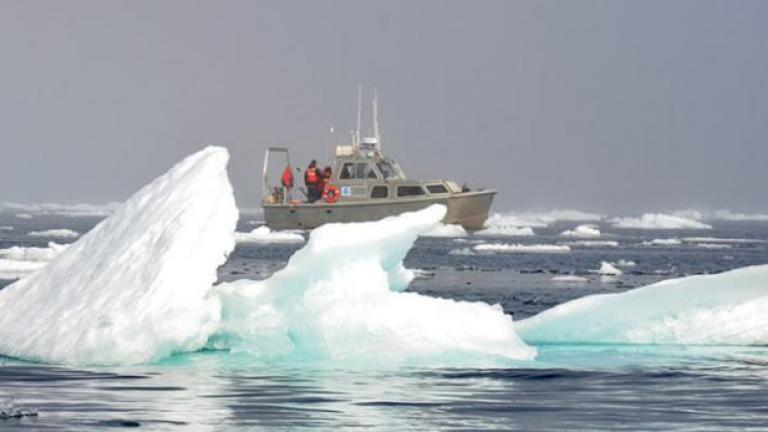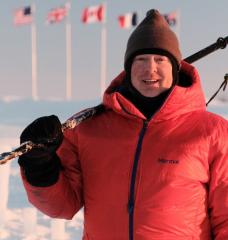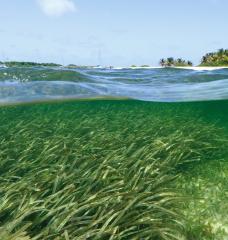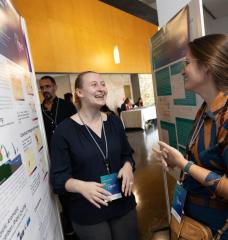
Hannah Thomasy | AGU EOS
Tuesday, April 7, 2020
The rapid changes happening in the Arctic Ocean, including increasing freshwater input, could dramatically affect its ability to store carbon, a study from EAPS Principal Research Scientist Ryan Woosley finds.
Read this at AGU EOS
Historically, scientists have believed that the Arctic Ocean will be an important carbon sink in the coming years—ice melt will increase the surface area that’s exposed to the air, facilitating carbon uptake from the atmosphere, and cold Arctic waters can store more carbon dioxide (CO2) than warmer waters.
Or at least that’s what was supposed to happen. But scientists have begun to suspect that this might not be the case, and new research suggests that the Arctic Ocean is, in fact, not as reliable a carbon sink as we thought. Using data from three research cruises (in 1994, 2005, and 2015), scientists were able to chart how the physical properties of the Arctic Ocean (including total alkalinity, temperature, and dissolved inorganic carbon) changed over time.
They found that over the course of the past 20 years, although the amount of CO2 in the atmosphere has gone up, the amount of dissolved inorganic carbon in Arctic waters has unexpectedly decreased.
That’s because reduced sea ice isn’t the only major change that’s happening in the Arctic Ocean.
“There’s actually been a huge increase of fresh water into the Arctic Ocean,” said Ryan Woosley, a marine physical chemist at the Massachusetts Institute of Technology and lead author of the study. “The Arctic is kind of unique compared to the other oceans because there’s a huge amount of river input compared to the size of the ocean…and fresh water has a very low alkalinity or buffering capacity, so this has reduced the ability of the Arctic Ocean to take up CO2.”
But Manfredi Manizza, a biogeochemical oceanographer at the Scripps Institution of Oceanography, said that although there has, indeed, been an increased input of fresh water to the Arctic Ocean, the reasons for the less-than-expected uptake of anthropogenic carbon may be slightly more complicated than the explanation presented in the paper. He said that different rivers carry different amounts of total alkalinity and dissolved inorganic carbon into the Arctic Ocean, so understanding these inputs is an important part of determining the ability of the Arctic to take up atmospheric CO2. Furthermore, there are many other changes taking place in the Arctic at the same time, each of which could also affect the ability of the ocean to take up CO2.
“There could be other pieces of the story that we don’t know about yet,” he said. “There are so many physical and biogeochemical processes that are linked together that determine the [CO2] uptake in the end.”
Manizza pointed out that temperature is increasing rapidly in the Arctic Ocean—much faster than it’s increasing in the other oceans. And changing temperatures are associated with a whole suite of other changes: Sea ice is melting, removing a protective barrier between the ocean and the wind, which could affect ocean stratification. Warmer temperatures and changes in ocean stratification could affect the amount and the types of primary producers that can live in the Arctic. All of these factors, either directly or indirectly, may affect the amount of CO2 that the Arctic Ocean can absorb from the atmosphere.
Arctic Freshening
However, Manizza agreed that Arctic freshening is occurring, which could have major implications for Arctic Ocean ecosystems.
“The fresh water and this lowering alkalinity are causing a rapid decrease in pH,” said Woosley. This means that like many other oceans, the Arctic is becoming more acidic.
Although the effects of Arctic Ocean acidification are not fully understood, Manizza said that acidification could alter the types of plankton that are able to survive there, which could in turn affect animals higher up the food chain. There are even concerns that acidification could threaten economically important Arctic fisheries.
Furthermore, Woosley said the Arctic not being an effective carbon sink could have important global implications: “More [CO2] will stay in the atmosphere, increasing global warming.”
Ultimately, both Woosley and Manizza agree that more data are needed. Woosley is hoping that another research cruise will take place in 2025, which would help to expand our knowledge of a region historically difficult to study. He hopes that having more data will shed light on the dynamics of Arctic Ocean freshening and acidification, which could affect Arctic ecosystems and fisheries, and Arctic Ocean CO2 uptake, which could affect the climate of our entire planet.
Citation: Thomasy, H. (2020), The Arctic Ocean may not be a reliable carbon sink, Eos, 101, https://doi.org/10.1029/2020EO142366. Published on 07 April 2020.
Text © 2020. The authors. CC BY-NC-ND 3.0





